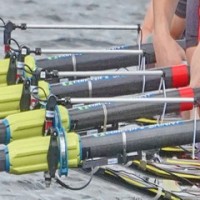Tools and methods in Rowing Biomechanics

Q: Rowers and coaches regularly ask: What is the difference between our BioRow systems and others available on the market?
A: These days, the most popular commercial systems are the Nielsen-Kellerman EmPower instrumented oarlocks, and Peach telemetry. These systems use different measurement methods: Peach measures pin force and gate angle; NK EmPower and BioRow Glance both measure force and angle at the gate and the BioRowTel system measures handle force and oar angles. We already discussed and compared these methods mechanically (RBN 2010/03, 2017/03-04) and what follows consists of more practical points.
There are two main methods of any measurements: monitoring and inspection:
- Monitoring is a process to periodically collect information about the object and react quickly to changes in their condition and functioning.
- Inspection implies less frequent checkpoints to deeper assess the object condition and functioning, compare its data with standards, diagnose possible problems and propose interventions to improve it.
Gate based systems EmPower and Peach are user-oriented and convenient for monitoring, but their limited information may be insufficient to solve significant problems and outline radical changes. The BioRowTel system on the other hand is better for inspection, provides more comprehensive and accurate information, however the greater degree of sophistication requires significant learning and experience to use it.
Similarly in medicine, you can purchase various gadgets (thermometers, blood pressure monitors, etc.) to monitor and control your health every day yourself, but in case of a more serious problem you may need to see a doctor, who uses a more professional inspection (MRI, blood test, etc.) for diagnosis and treatment.
Some rowing coaches like simpler monitoring systems, others prefer in-depth testing with BioRow system, and some successfully combine both methods.
Q: Can biomechanics systems be used for rowers’ selection in big boats?
A.: We have already discussed selection (RBN 2021/01) and pointed to potential problems of using biomechanics in it. Except missing psychological factors and possible sensor inaccuracy, there is a systematic phenomena of force/power transfer through the hull from the stretcher of one rower - to the gate and oar of other rower (RBN 2012/04), which affects measured data, and therefore evaluation and selection in a crew boat.
Concluding: biomechanical measurements can only assist in – not decide – crew selection. The whole combination of variables should be analysed, including crew synchronisation and the final decision must be verified with a rowing speed assessment.
©2023 Dr. Valery Kleshnev www.biorow.com
Full text is available for BioRow members only: https://biorow.com/membership/



